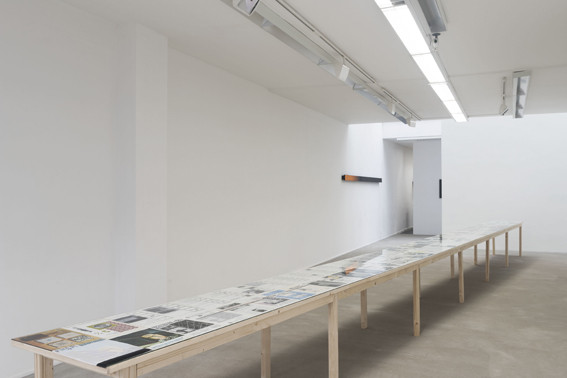Cevdet Erek
27 Nov 2014 - 24 Jan 2015
CEVDET EREK
Faça
27 November 2014 - 24 January 2015
Erek lets you feel the rhythm of the city
Modern cities have a complex yet urgent rhythm about them which has appealed to artists for a very long time - remember Mondrian’s Victory Boogie Woogie. However, what happens when you combine that rhythm with a culture in which modernism takes on a completely different meaning? This alone makes Turkish artist Cevdet Erek’s Faça exhibition at Galerie Akinci intriguing. Erek studied as an architect and as a percussionist, and this combination, which on the face of it is somewhat unexpected, is a constant presence in his work. His installations, films and LED light bars are all full of rhythms: of day and night, of buildings, of the city and of illegible texts on façades, all with their own unmistakable logic. Erek’s rhythms often seem too complex to take in, but you still feel their beat, their urgency - as if he has discovered a logic in the world of buildings that you don’t immediately see, but are able to feel, the way you do with music or good abstract paintings. It means Erek’s work is not simple, but it is definitely worth the effort. With the exception of one LCD screen that indicates the number of ‘light minutes’ during the exhibition, the five works that he is currently exhibiting at Akinci are mainly about the tension between modernist architecture, Southern European culture (Greece and Turkey) and the extent to which the individual can influence such large mechanisms. On a table there is a 1970 copy of the Greek architecture magazine, Arkitektoniki, in which Erek has placed a number of additions, scribbles and collages, as a colleague might do. However, more incisive is the Avluda/In the Courtyard installation in which Erek has cut the view of an Istanbul courtyard into a modernist film collage. In their rhythmic abstraction, the buildings filmed take on a whole new meaning and that makes it all the more confusing when, occasionally, someone suddenly appears behind a window, on a roof. They don’t actually belong there, in the same way that people have no place in an abstract Mondrian, but you are still pleased to see them.
Hans den Hartog Jager
In: NRC, 19 December 2014
Faça
27 November 2014 - 24 January 2015
Erek lets you feel the rhythm of the city
Modern cities have a complex yet urgent rhythm about them which has appealed to artists for a very long time - remember Mondrian’s Victory Boogie Woogie. However, what happens when you combine that rhythm with a culture in which modernism takes on a completely different meaning? This alone makes Turkish artist Cevdet Erek’s Faça exhibition at Galerie Akinci intriguing. Erek studied as an architect and as a percussionist, and this combination, which on the face of it is somewhat unexpected, is a constant presence in his work. His installations, films and LED light bars are all full of rhythms: of day and night, of buildings, of the city and of illegible texts on façades, all with their own unmistakable logic. Erek’s rhythms often seem too complex to take in, but you still feel their beat, their urgency - as if he has discovered a logic in the world of buildings that you don’t immediately see, but are able to feel, the way you do with music or good abstract paintings. It means Erek’s work is not simple, but it is definitely worth the effort. With the exception of one LCD screen that indicates the number of ‘light minutes’ during the exhibition, the five works that he is currently exhibiting at Akinci are mainly about the tension between modernist architecture, Southern European culture (Greece and Turkey) and the extent to which the individual can influence such large mechanisms. On a table there is a 1970 copy of the Greek architecture magazine, Arkitektoniki, in which Erek has placed a number of additions, scribbles and collages, as a colleague might do. However, more incisive is the Avluda/In the Courtyard installation in which Erek has cut the view of an Istanbul courtyard into a modernist film collage. In their rhythmic abstraction, the buildings filmed take on a whole new meaning and that makes it all the more confusing when, occasionally, someone suddenly appears behind a window, on a roof. They don’t actually belong there, in the same way that people have no place in an abstract Mondrian, but you are still pleased to see them.
Hans den Hartog Jager
In: NRC, 19 December 2014

